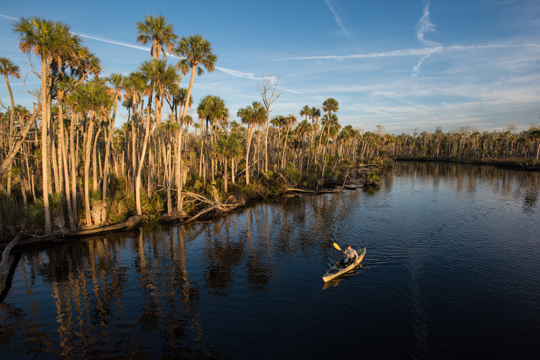
Meet the expedition team at E.O. Wilson Biophilia Center
On Saturday, March 7, 2015, the Florida Wildlife Corridor Expedition will be coming to the E.O. Wilson Biophilia Center to share their journey and mission from across the state of Florida. The day will coincide with a kid-friendly “Black Bear Affair” from 10 a.m. – 3 p.m. Tours of the interactive nature center, guided hikes, and bear themed arts and crafts, such as casting bear tracks will be offered.

The expedition group is a conservation advocacy organization focused on connecting, protecting and restoring corridors of conserved lands and waters essential for the survival of Florida’s diverse wildlife. Through their journey, the organization is showcasing the need to protect the missing links in the corridor, preserve Florida’s waters, and sustain working lands and rural economies from the Everglades to Georgia and Alabama. The Corridor addresses the fragmentation of natural landscapes and watersheds from the Everglades ecosystem north. Contributing to the fragmentation problem is a disconnection between the perceptions of Floridians, and the real need to keep natural systems connected. The group aims to mend the perception gap through an education and awareness campaign.
“If we show Floridians the panthers, bears, native cultures, ranchlands and rivers—and how they are all connected—then they can help us make the Florida Wildlife Corridor a reality,” the group says.
The Corridor launched the initial leg of their journey in 2012, and traversed the Everglades ecosystem to the Okefenokee National Wildlife Refuge. The trek covered over 1,000 miles in 100 days. The second 1,000 mile, 100 day, leg takes them from the Everglades headwaters through Walton county and finishing at Gulf Islands National Seashore in mid March 2015.
Learn more about the group at floridawildlifecorridor.org.
Corridor facts:
• The Florida Wildlife Corridor encompasses 15.8 million acres — 9.5 million acres that are already protected and 6.3 million acres of remaining opportunity area that do not have conservation status. The exact proportion of the opportunity area that needs to be protected for functional connectivity within the corridor has not yet been determined.
• Protected areas include 4.7 million acres of federal land, 4.5 million acres of state land, 162,776 acres of county and city land and 204,232 acres of private land with permanent conservation status.
• There are 1.46 million acres within the corridor opportunity area that are high priority for conservation through the state of Florida’s Florida Forever program and approximately 600,000 acres that are priorities for conservation through U.S. Fish and Wildlife Service’s Greater Everglades Program (including the new 150,000-acre Everglades Headwaters National Wildlife Refuge and Conservation Area project).
• The corridor provides habitat for 42 federally listed endangered species, 24 threatened species and 15 candidate species. At the state level, there are an additional 176 species listed as endangered, 56 as threatened and 29 as species of special concern.
• Examples of threatened and endangered species include crested caracara, Everglades snail kite, Florida grasshopper sparrow, Florida scrub-jay, red-cockaded woodpecker, whooping crane, wood stork, Florida panther, West Indian manatee, green sea turtle, leatherback sea turtle, hawksbill sea turtle, Gulf sturgeon, Okaloosa darter, sand skink, Eastern indigo snake, frosted flatwoods salamander, Highlands tiger beetle, Choctawhatchee beach mouse, piping plover, Etoniah rosemary and Okeechobee gourd.
• There are 992 named rivers and streams crossing the Corridor that include 1,150 miles of designated paddling trails. There are 920 miles of the Florida National Scenic Trail within the corridor.
The team:
Mallory Lykes Dimmitt, Conservationist
Mallory Lykes Dimmitt is a seventh generation Floridian whose childhood was partly spent exploring the lands and waters of Central Florida. She pursued her passion for the outdoors into a career, receiving her B.S. in natural resources from the University of the South in Sewanee, Tennessee. She was also awarded a Doris Duke Conservation Fellowship at Duke University’s Nicholas School of Environment where she earned a master’s of environmental management.
Some of Mallory’s projects include protecting river corridors and large landscapes in Southwest Colorado and across the Colorado Plateau with the Nature Conservancy, research abroad for the International Water Management Institute and strategic planning and organizational development for the Florida Wildlife Corridor.
Joe Guthrie, Wildlife Biologist
Joe Guthrie is a wildlife biologist based in St. Petersburg. He works as a consultant for the National Wildlife Refuge Association. Joe is a graduate of Centre College with a bachelor’s degree in English, as well as a master’s of science in forestry from the University of Kentucky.
Joe’s graduate school research on Florida black bears in South Central Florida provided the inspiration for the 2012 Florida Wildlife Corridor Expedition, and was a key factor in the establishment of Everglades Headwaters National Wildlife Refuge. His work with NWRA focuses on expanding the National Wildlife Refuge System throughout the Gulf Region, including the Florida Everglades.
Carlton Ward Jr., Conservation Photographer
Carlton Ward Jr. is a conservation photographer and eighth generation Floridian focused on Florida’s living heritage. His work has been published in Audubon, Smithsonian, Geo, Nature Conservancy and National Geographic magazines and regularly in the Tampa Bay Times, where he was a photo intern in 2001. His books include the Edge of Africa (2003), Florida Cowboys (2009) and Florida Wildlife Corridor: Everglades to Okefenokee (2013).
Carlton has a master’s in ecology from the University of Florida and wrote the first thesis on the field of conservation photography. He is a founding member of the International League of Conservation Photographers (ILCP), National Geographic Explorer and Fellow of the Explorers Club. He founded the Florida Wildlife Corridor campaign in 2010.
